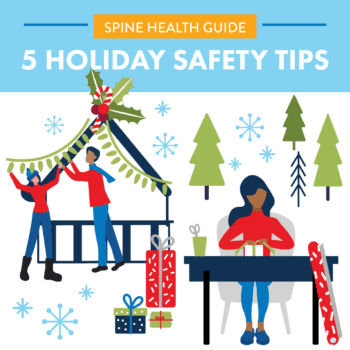Did you know that the average American adult spends around 8 hours per day looking at a phone or computer screen? On average, children ages 8-12 in the United States spend 4-6 hours a day watching or using screens, and teens spend up to nine hours.
Yet, looking down at a screen can put technology users at risk of developing tech neck. This condition, also known as “text neck,” is a term that describes the pain and strain to the cervical spine and its supporting muscles, by looking down at a cell phone, tablet, or other screens for long intervals on a regular basis.
As your head leans forward to stare down at the screen, the heavy weight of gravity is no longer evenly distributed throughout your body and is concentrated onto your head and neck. The muscles strain as the head becomes increasingly heavy, adding as much as 60 pounds of pressure. As little as a 45-degree head tilt forward means your muscles are doing the work of lifting a 50-pound bag of potatoes! And the more people look down and at longer periods of time, the increased weight on the neck is equivalent to carrying an 8-year-old on your neck for nearly 60 hours a week!
This is a cumulative problem that will affect young people more than previous generations. They will experience longer exposure over time due to poor posture, especially when coupled with computer use for activities like homework and gaming. Tech neck symptoms include headaches, neck pain and stiffness, shoulder pain and tingling or numbness that radiates down the arm. The condition can also lead to headaches, neurological issues, decreased respiratory capacity, degenerative disc disease, and even depression. For youth, chronic poor posture can contribute to degenerative problems that lead to permanent spinal alignment issues into adulthood.
Thankfully, technology users do not have to completely give up screen time to prevent pain and injuries from tech neck. Instead, the National Spine Health Foundation has launched our ‘Look Up’ campaign to help people easily remember these tech neck prevention tips:
- Time it. Look up from your device frequently and set timers to remind yourself to move regularly.
- Stack it. Keep your head stacked over your spine and hold your device at eye level.
- Lean it. Relieve disc pressure by combining good lumbar support and leaning your seat back at a 25-degree angle.
- Work it. Practice neck, back and core strengthening exercises regularly.
If you are someone that struggles with neck or back pain caused by tech neck, the National Spine Health Foundation invites you to join our private support group and be encouraged by others on a similar journey toward healing. We also have resources available to help you learn more about prevention, diagnosis, treatment, and most importantly recovery.
Tech-Neck-Infographic


